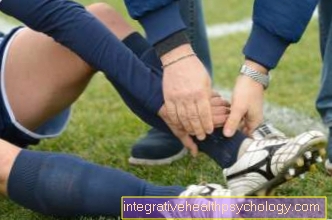Sprained foot
definition
A sprain (Distortion) of the foot describes an overstretching of the ligaments of the foot or the joint capsule of the ankle joints. The ligaments of the foot represent connections between the bones of the foot and those of the lower leg. Just like the joint capsule, they stabilize and secure the ankle joint by dictating the physiological range of motion of the joint due to their limited flexibility, so that the foot can only be extended to a limited extent can twist. Although this gives the bony joint a certain protection, it is precisely because of this limited elasticity of the ligament structures that they can be overstretched (sprained) or, in the worst case, even torn (ligament tear, rupture) in the event of trauma. The term “sprain” is misleading because the underlying injury mechanism is not a compression of the foot, but a stretching of the ligaments. Spraining the foot is a very common type of injury among sports injuries.
root cause

The root cause for sprained ankle, usually provides one Move represent that about the physiological and intended Extent extends beyondas is the case, for example, when the foot is twisted. This will make the Joint stabilizing ligaments overstretchedwhat is called a sprain of the foot. A typical injury pattern for a sprained foot is the so-called Supination trauma. The supination trauma (twisting the foot) was named after the underlying movement, the supination. Here buckles the ankle so that the inner edge of the foot lifted and the lower edge of the foot becomes and consequently the Outer ankle deviates outwards. This will make the Outer ligaments of the foot overstretched and most commonly affected by this is that Talofibular anterior ligament, so that front band, that this Ankle bone (Talus) with the Fibula of the lower leg (Fibula) connects. The ligament that holds the heel bone (Calcaneus) with the fibula (Fibula) connects and therefore Calcaneofibular ligament is called. Just the posterior ligament connection is rare between the ankle and fibula (Posterior talofibular ligament) affected by a sprain.
As one of the most common sports injuries a sprained foot often occurs during sports where Jumps required are and you are at Slightly bend the surface when it hits the ground can, for example in basketball. Other sports that can quickly sprain your foot include Running sports like jogging but also hiking, especially on uneven ground where it is easy to twist your ankle. But often lead too even small trauma in everyday movements a sprained foot, such as twisting an ankle on a curb.
However, it is not only excessive and unphysiological movements of the foot that lead to a sprain, but also external forces acting on the ankle or foot, for example with a accident can arise. It is also easier to get a sprained foot if it is personal prehistory already multiple sprains has come. Here the Ligamentous apparatus of the foot by the repeated overloading and stretching so far Worn-out be that he himself no longer fully regenerated and thus can no longer reliably perform its stabilizing function on the joint. As a result, it can even be a slight stretch of the ankle due to the lack of ligament tension (Ligament insufficiency) more likely to sprain the foot again.
Also a sprain is going through already existing misalignments of the foot, such as by a Arches foot, favored.
Appointment with ?

I would be happy to advise you!
Who am I?
My name is dr. Nicolas Gumpert. I am a specialist in orthopedics and the founder of .
Various television programs and print media report regularly about my work. On HR television you can see me every 6 weeks live on "Hallo Hessen".
But now enough is indicated ;-)
Athletes (joggers, soccer players, etc.) are particularly often affected by diseases of the foot. In some cases, the cause of the foot discomfort cannot be identified at first.
Therefore, the treatment of the foot (e.g. Achilles tendonitis, heel spurs, etc.) requires a lot of experience.
I focus on a wide variety of foot diseases.
The aim of every treatment is treatment without surgery with a complete recovery of performance.
Which therapy achieves the best results in the long term can only be determined after looking at all of the information (Examination, X-ray, ultrasound, MRI, etc.) be assessed.
You can find me in:
- Lumedis - your orthopedic surgeon
Kaiserstrasse 14
60311 Frankfurt am Main
Directly to the online appointment arrangement
Unfortunately, it is currently only possible to make an appointment with private health insurers. I hope for your understanding!
Further information about myself can be found at Dr. Nicolas Gumpert
Symptoms
Pain usually occurs immediately after a trauma that resulted in a sprained foot. Although these are particularly triggered by moving the foot and stepping on the floor, they often also exist at rest. Usually swelling occurs within a few minutes after the foot has been sprained, which is caused by an injury to surrounding blood vessels and consequent bleeding under the skin. In addition, there is often a bruise several hours after the trauma for the same reason (Hematoma), which is why the sprained area appears bluish. Since the ligaments are still intact when the ankle is sprained and at least partially perform their stabilizing function, at least in theory the movements typical for the joint can still be performed, which in contrast to a torn ligament or a bone fracture only partially or also would not be possible at all. A sprain of the foot can still lead to restricted mobility, which is due to the pain associated with it.
Also read: Bump on foot
diagnosis
Since symptoms similar to those of a torn ligament occur with a sprain of the foot, i.e. the stretching of the stabilizing ligament apparatus, a doctor should be consulted in order to be able to quickly initiate adequate therapy in the event of a torn ligament or other accompanying injuries that have a poor prognosis if untreated . In the anamnesis interview, the doctor first asks about the exact symptoms and the course of the accident, which often already provides information about the injured structures. For example, the accident mechanism of the supination trauma is typical for an injury to the external ligament (ligamentum talofibulare anterius). This is followed by an examination of the foot, during which the inspection looks for typical symptoms such as swelling and a bruise. The doctor will also check whether pressure pain can be triggered over the affected area. Specific ligament tests are used to determine whether the foot is abnormally mobile, which is more likely to indicate a torn ligament or even a broken bone. To rule out these injuries, an X-ray of the foot and ankle is often taken. Other imaging measures such as an MRI (MRI) are rarely used to exclude further accompanying injuries to the bones or cartilage.Magnetic resonance imaging) or a CT (Computed Tomography) required.
Read more on the topic: Torn ligament
therapy
A sprained foot heals by itself. But this process can decisively supported and the Healing time Consequently shortened become. An important guideline for the First aid an ankle sprain is what is called PECH rule (P = break; E = ice; C = compression; H = lie on top). Quite crucial for one quick healing is this immediate termination of the load on the foot right after the trauma and also one Protection one to two weeks after the sprain (P). This can be done by a Bandage made of elastic material supported on the one hand stabilizing acts on the ankle, causing the Ligaments then relieved and can heal in peace. On the other hand, the association carries through a minimal immobilization of the joint while still maintaining mobility of the foot to protect it.
This is also important in the first few days after the sprain Cooling the ankle (E). This can be done with the help of a Cool packs or with Ice cubes that have been wrapped in a towel, for example direct skin contact and thus avoid frostbite. By cooling the Relieved pain And also the swelling goes the sprained foot faster back. Also represents the Compression of the ankle with the help of elastic bandages is an important pillar in acute care after trauma (C). This compression reduces the space into which the injured blood vessels can bleed, so that an attempt is made to To counteract the formation of the bruise.
In addition, a decongestant and pain reliever ointment be applied. The swelling of the sprained ankle is additionally caused by Elevating the foot promoted, as this on the one hand protects the foot and on the other hand less blood flows into the foot due to the force of gravity, which could cause a bruise or swelling. After these first steps you should also consulted a doctor quickly be that accompanying injuriesthat should be treated differently, exclude supposed to To avoid consequential damage. If necessary, he can with very severe pain of the sprained foot too Painkiller prescribe. In summary, a sprained foot is treated without any accompanying injuries conservativewithout surgery.
forecast
At simple sprain with no accompanying injury like broken bones there is one very good prognosis and the Healing of the stretched ligaments usually only takes one to two weeks in claim. However that is Time to complete resilience of the foot clearly longer, because after healing only gradually started again with the load on the foot and this only slowly increased should be. But mostly lies three months later another complete resilience of the ankle.
prophylaxis
An important aspect of the prevention of sprains of the foot is a strong muscular system of the leg, which additionally supports the joint-stabilizing function of the ligaments. As a prophylactic, we recommend warming up before physical activity, i.e. stretching the stressed muscles and ligaments on the one hand, and increasing the intensity of the load only slowly on the other. In addition, coordination exercises designed to train the sense of balance help prevent falls, which can potentially lead to ankle sprains. The risk of twisting the foot by wearing shoes that go beyond the ankle can also be reduced, or forces that arise from twisting can be well absorbed by these shoes. This plays a particularly important role in sporting activities such as hiking, where you can bend over quickly on uneven ground, and also in basketball. In addition, athletes who have had frequent foot sprains in their history use stabilizing bandages to prevent further foot sprains.
Please also read our article on this Duration of a sprain.





























